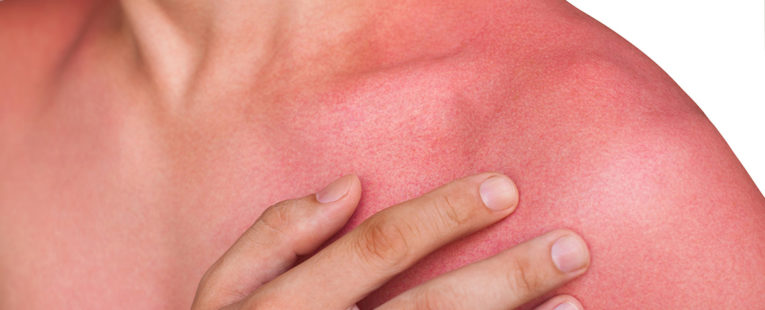Don’t like the look of that rash?
Your skin sure does take the brunt of summer’s hot, humid and sunny weather.
Too much sun can cause a rash. Too much heat can cause a rash. But what’s the difference, how do you treat them and how do you avoid getting them?
Melinda Cooling, vice president of Advanced Practice Providers at OSF HealthCare and chief clinician executive for OSF Saint Gabriel Health, breaks it down for us.
Heat rash

Heat rash, also known as prickly heat, often occurs during hot, humid weather. This rash usually appears in areas where the skin folds or areas where clothes causes friction like armpits, elbow creases, or the groin area.
“This type of rash often is not related to sun exposure but rather when blocked pores trap sweat under the skin,” Melinda said. “A patient may have small blisters or a deep lump that can feel prickly or itchy.”
Other than the hot humid weather, heat rash can develop due to:
- A lot of physical activity
- Illness with fever
- Tight or warm clothing
- Bandages
- Medicine patches that stick to the skin
Treatment
“Most of the time, heat rash will resolve on its own by cooling the skin with cool compresses and avoiding exposure to the heat,” Melinda said.
Other treatment options may include:
- Using a gentle exfoliator in the bath or shower
- Corticosteroid cream or lotion to help reduce itching and inflammation
- Antibiotic cream or lotion if bacteria is part of the cause
- Drying powders
“If you would have increased pain, swelling, or redness around the affected area or a fever, it could be a sign of an infection and you should seek urgent care,” Melinda said.
Prevention
Sometimes in the summer, to prevent heat rash may require changing clothes more frequently and keeping the skin cool and dry.
Other ways to prevent heat rash:
- Wear lightweight, loose clothing
- Wear fabric that lets air get to the skin, such as cotton
- Remove bandages or patches
Sun rash
 Sun rash starts in areas where the skin is exposed to sunlight.
Sun rash starts in areas where the skin is exposed to sunlight.
“It usually presents as a red, itchy rash that groups together and it can feel like it is burning,” Melinda said. “Normally it shows within hours of the sun exposure. If the burn is severe, some patients may feel nauseated or feverish.”
Treatment
Most sun rashes will resolve on its own within 10-14 days, she said.
“Over-the-counter aloe vera or anti-itch ointments can be helpful. Cool compresses or a cool bath can provide itch relief,” Melinda said. “If you have blisters, keep them clean and dry to help to prevent infection.”
If you have increased pain, fever, swelling or redness, you may have an infection and should seek urgent care, she said.
Prevention
“The key to sun rash is prevention by using sunscreen with an SPF of at least 30 and to reapply the sunscreen every two hours or more often if you’re swimming or perspiring,” Melinda said. “Protect your skin with clothing and wear a wide-brimmed hat. Avoid the sun between 10 a.m. and 2 p.m. when the sun is most intense.”
Seek urgent care
Whether you’re dealing with a heat rash or a sun rash and aren’t sure what to do, you can seek out urgent care at an OSF OnCall Urgent Care or OSF PromptCare clinic or go online and connect with a board-certified advanced practice provider at OSF OnCall.
Last Updated: May 22, 2023
